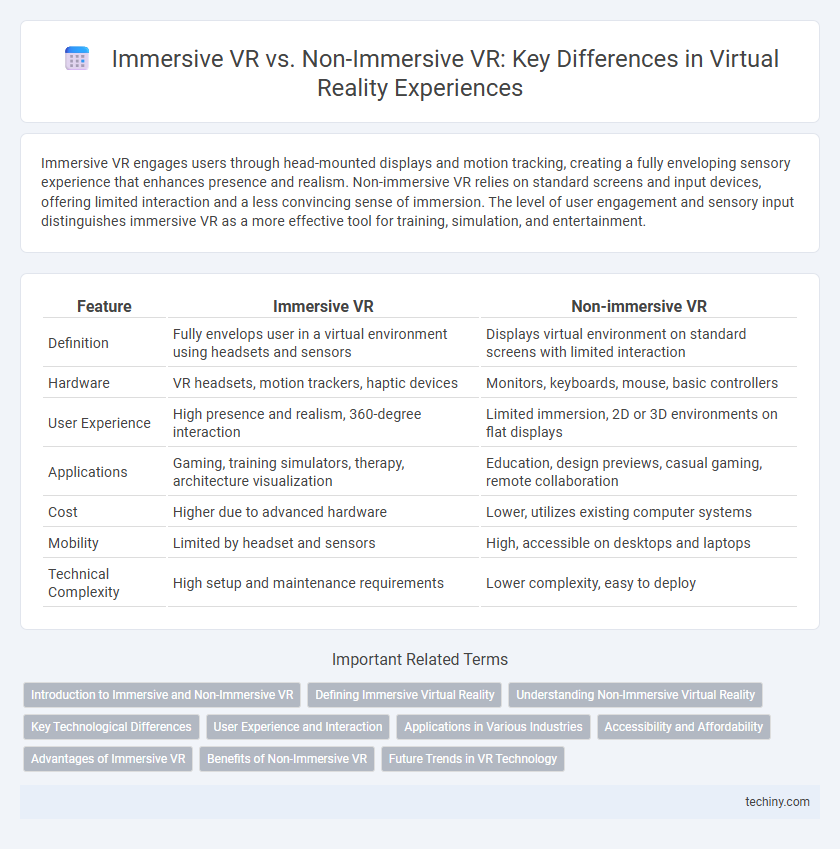Immersive VR engages users through head-mounted displays and motion tracking, creating a fully enveloping sensory experience that enhances presence and realism. Non-immersive VR relies on standard screens and input devices, offering limited interaction and a less convincing sense of immersion. The level of user engagement and sensory input distinguishes immersive VR as a more effective tool for training, simulation, and entertainment.
Table of Comparison
| Feature | Immersive VR | Non-immersive VR |
|---|---|---|
| Definition | Fully envelops user in a virtual environment using headsets and sensors | Displays virtual environment on standard screens with limited interaction |
| Hardware | VR headsets, motion trackers, haptic devices | Monitors, keyboards, mouse, basic controllers |
| User Experience | High presence and realism, 360-degree interaction | Limited immersion, 2D or 3D environments on flat displays |
| Applications | Gaming, training simulators, therapy, architecture visualization | Education, design previews, casual gaming, remote collaboration |
| Cost | Higher due to advanced hardware | Lower, utilizes existing computer systems |
| Mobility | Limited by headset and sensors | High, accessible on desktops and laptops |
| Technical Complexity | High setup and maintenance requirements | Lower complexity, easy to deploy |
Introduction to Immersive and Non-Immersive VR
Immersive VR fully envelops users in a simulated environment through advanced headsets and motion tracking, creating a highly interactive and realistic experience. Non-immersive VR, often accessed via desktop screens or mobile devices, offers virtual interaction without complete sensory immersion. The distinction lies in the level of sensory engagement and user presence, impacting applications across gaming, training, and education.
Defining Immersive Virtual Reality
Immersive Virtual Reality (VR) creates a fully enveloping digital environment using head-mounted displays, spatial audio, and motion tracking to simulate realistic sensory experiences. This form of VR enables users to interact naturally within a three-dimensional virtual space, enhancing presence and engagement compared to non-immersive VR, which relies on traditional screens without complete sensory immersion. Key technologies defining immersive VR include advanced sensors, haptic feedback devices, and real-time rendering systems that facilitate seamless interaction and depth perception.
Understanding Non-Immersive Virtual Reality
Non-immersive virtual reality delivers interactive experiences through standard computer screens or mobile devices, enabling users to engage with digital environments without complete sensory immersion. This format primarily utilizes input devices such as keyboards, mice, or game controllers, allowing for controlled interaction within a virtual space. Non-immersive VR is widely applied in education, training simulations, and remote collaboration where full immersion is less critical but accessibility and ease of use remain important.
Key Technological Differences
Immersive VR employs advanced head-mounted displays (HMDs) with motion tracking, spatial audio, and haptic feedback to create a fully enveloping sensory experience, whereas non-immersive VR relies on standard screens with limited interactivity. Immersive systems use six degrees of freedom (6DoF) tracking to enable natural movement within a virtual environment, contrasting with the constrained input methods of non-immersive setups, which typically utilize mouse or keyboard controls. The integration of real-time rendering engines and sensor fusion in immersive VR enhances presence and user engagement, while non-immersive VR depends more on predefined visuals and simpler interaction models.
User Experience and Interaction
Immersive VR delivers a fully encompassing user experience through head-mounted displays and motion tracking, enabling natural interaction within a 3D environment that enhances spatial awareness and presence. Non-immersive VR relies on standard screens and input devices like keyboards or controllers, offering limited sensory engagement and less intuitive interaction, which can reduce the sense of immersion. The depth of interaction in immersive VR supports complex tasks and emotional involvement, while non-immersive VR suits simpler applications with easier accessibility but diminished realism.
Applications in Various Industries
Immersive VR, characterized by fully enveloping environments using headsets and motion tracking, revolutionizes industries like healthcare for surgical simulations, real estate through virtual property tours, and education by enabling interactive learning experiences. Non-immersive VR, accessible via standard screens and controllers, supports applications in training simulations for automotive design, remote maintenance in manufacturing, and virtual prototyping in product development. Both forms enhance operational efficiency and user engagement, with immersive VR offering deeper experiential interaction and non-immersive VR providing broader accessibility.
Accessibility and Affordability
Immersive VR typically requires advanced hardware like head-mounted displays and motion sensors, which limits accessibility due to higher costs and technical complexity. Non-immersive VR runs on standard computers or mobile devices, making it more affordable and accessible to a broader audience. The cost difference influences user adoption, with non-immersive VR serving as an entry point for educational and casual entertainment purposes.
Advantages of Immersive VR
Immersive VR offers a heightened sense of presence by utilizing advanced head-mounted displays and spatial audio, creating a fully enveloping virtual environment that enhances user engagement and realism. This deep sensory involvement improves training efficacy and simulation accuracy, making it ideal for complex skill development in fields like healthcare and aviation. The active interaction with 3D virtual spaces promotes better spatial awareness and memory retention compared to non-immersive VR setups displayed on standard screens.
Benefits of Non-Immersive VR
Non-immersive VR enables users to interact with virtual environments through standard computer interfaces, offering greater accessibility and lower cost compared to fully immersive systems. This form of VR supports multitasking and communication with the physical world, enhancing usability in educational and professional training contexts. Its reduced hardware requirements and minimal motion sickness make it a practical choice for extended use and broader user adoption.
Future Trends in VR Technology
Immersive VR, characterized by fully enveloping environments with advanced headsets and motion tracking, is evolving towards more realistic sensory integration and greater interactivity, enhancing user presence and engagement. Non-immersive VR, typically delivered through standard screens and limited interaction, is gaining traction in educational and training applications due to its accessibility and lower cost. Future trends highlight the convergence of immersive VR with AI-driven personalization and 5G connectivity, driving more seamless, responsive, and scalable virtual experiences.
Immersive VR vs Non-immersive VR Infographic

 techiny.com
techiny.com